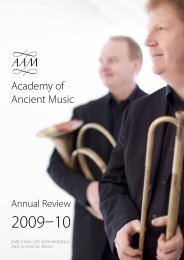JS Bach's forebears (PDF) - Academy of Ancient Music
JS Bach's forebears (PDF) - Academy of Ancient Music
JS Bach's forebears (PDF) - Academy of Ancient Music
You also want an ePaper? Increase the reach of your titles
YUMPU automatically turns print PDFs into web optimized ePapers that Google loves.
like figures and rhythmically vigorous writing,<br />
before a concluding section <strong>of</strong> echo phrases.<br />
The Sonata in F <strong>of</strong>fers a memorable succession<br />
<strong>of</strong> distinctive ideas: the opening Presto uses a<br />
tattoo <strong>of</strong> repeated notes in a long descending<br />
sequence; then, for the rest <strong>of</strong> the piece, short<br />
yet languishing cadences alternate with<br />
vigorous fanfare- like figures.<br />
Heinrich Bach’s second son was Johann Michael<br />
Bach (1648–94), who began his career in his<br />
father’s homeplace <strong>of</strong> Arnstadt as organist at<br />
the castle chapel. From 1673 Johann Michael<br />
held the posts <strong>of</strong> organist and town clerk in<br />
Gehren, a small town in the Thuringian forest.<br />
His youngest daughter, Maria Barbara, married<br />
Johann Sebastian in October 1707. In Gehren,<br />
Johann Michael was characterised as “quiet,<br />
withdrawn and artistically well- versed”, while<br />
the family tree assembled by Johann Sebastian<br />
describes him as “an able composer”. Most <strong>of</strong><br />
Johann Michael’s compositional output consists<br />
<strong>of</strong> motets for eight- voice choir, a form <strong>of</strong> church<br />
music traditional in Thuringia. Indeed, the music<br />
theorist Friedrich Erhardt Niedt cheekily<br />
associated the motet with “Thuringian peasants”<br />
and “farmers’ daughters... [who] inherit their<br />
boots from their ancestors”.<br />
A handful <strong>of</strong> more ambitious pieces survive<br />
from Johann Michael Bach, including the<br />
dialogue ‘Liebster Jesu, hör mein Flehen’ for<br />
the Second Sunday in Lent. The dialogue<br />
dramatises the Gospel story <strong>of</strong> Jesus and the<br />
woman <strong>of</strong> Canaan (Matthew 15.21–28). The<br />
woman cries for Jesus’ mercy, but the disciples<br />
(represented by a three- voice chorus) try to<br />
send her away. Both the woman and the<br />
disciples sing simple rhymed texts, set to short,<br />
regular phrases <strong>of</strong> a somewhat winsome nature.<br />
Jesus’ words, however, are sung by a bass soloist<br />
whose extended phrases reflect the liberating<br />
power <strong>of</strong> his message: “Ich bin nicht gesandt<br />
denn nur zu den Verlornen vom Hause Israel...<br />
Doch, Weib, dein Glaub’ ist groß” (“I am not sent<br />
only unto the lost sheep <strong>of</strong> the house <strong>of</strong> Israel...<br />
4 ACADEMY OF ANCIENT MUSIC, 2010-2011 SEASON<br />
Surely, woman, thy faith is great”). The piece<br />
ends with a verse from the 1530 chorale ‘Wie<br />
sich ein Vat’r erbarmet’. It is unlikely that Johann<br />
Michael ever visited an opera house; but his<br />
dialogue shows how he brought a sense <strong>of</strong><br />
theatre to his church compositions.<br />
Whereas Johann Michael led a quiet and<br />
respectable life in Gehren, his elder brother<br />
Johann Christoph Bach (1642–1703) had a fiery<br />
and stubborn personality. For most <strong>of</strong> his life,<br />
Johann Christoph held the dual post <strong>of</strong> town<br />
organist and court keyboardist in Eisenach. His<br />
time here was marred by frequent quarrels with<br />
the town council, which he felt did not provide<br />
adequate financial recompense for his talent.<br />
Yet Johann Christoph was also highly respected<br />
as a composer, “strong in the invention <strong>of</strong><br />
beautiful ideas as well as in the expression <strong>of</strong><br />
the meaning <strong>of</strong> the words” (to quote the<br />
Obituary <strong>of</strong> Johann Sebastian). Certainly Johann<br />
Sebastian identified strongly with Johann<br />
Christoph’s output and may have even seen<br />
him as some kind <strong>of</strong> artistic model; <strong>of</strong> the<br />
manuscripts in the Altbachisches Archiv, it is<br />
mainly those <strong>of</strong> Johann Christoph’s motets that<br />
bear Johann Sebastian’s annotations.<br />
The large- scale cantata ‘Die Furcht des<br />
Herren’, written for the election <strong>of</strong> the Arnstadt<br />
town council, is <strong>of</strong>ten ascribed to Johann<br />
Christoph Bach, although recent research has<br />
suggested that it may be by his brother Johann<br />
Michael. Each <strong>of</strong> the vocal parts has symbolic<br />
significance: soprano 1 is the allegorical figure<br />
<strong>of</strong> Wisdom; other soloists represent the old and<br />
new chamberlains and burgomasters; and the<br />
four- part choir represents “the whole town<br />
council”. In a whimsical touch, the organ part<br />
represents the town clerk; this may be a<br />
reference to Johann Michael, who as mentioned<br />
above combined his musical duties with those<br />
<strong>of</strong> town clerk. Wisdom dispenses her advice in<br />
solo sections, which alternate with prayers and<br />
proclamations from the other vocalists. The fivepart<br />
string ensemble provides a rich and



